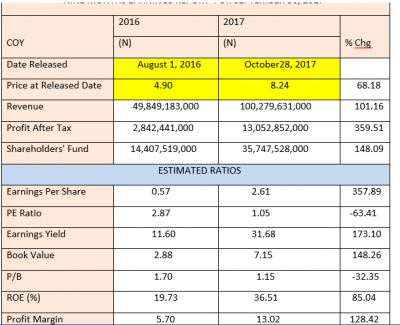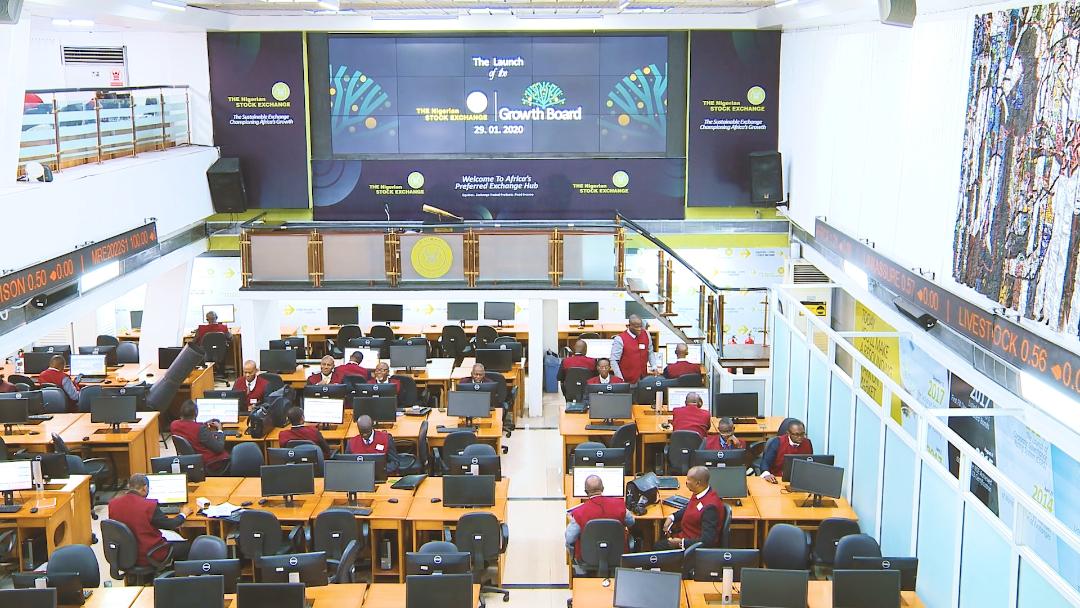Dangote Flour Returns To Profit, Strengthens Hope For Dividend After Six Years

The management of Dangote Flour Mills Plc presented its nine-month earnings report for the period ended September 30, 2017 in line with the post-listing requirement of the Nigerian Stock Exchange (NSE). It came later, when compared with that of 2016, due to the change in its financial year-end from September to December, a situation that also reflected on the numbers, compared to that of June 30, 2016.
The company’s performance for the period was impressive and reflected the expansion in Nigeria’s manufacturing sector as demonstrated by the Purchasing Managers Index (PMI) that has remained above 50 point for the seventh consecutive month in September. This supported reports of recovery in the nation’s economy, after months of huge losses suffered by manufacturers, particularly in the aftermath of the Naira devaluation arising from five consecutive quarters of recession (or negative GDP growth). This meant significant foreign exchange losses and intense pressure from the operating environment that negatively impacted cost and purchasing power of Nigerians that affected the financials of many consumer goods makers
Recall that Dangote Industries Limited recently reacquired the Dangote Flour Mills from South Africa’s Tiger Brands, under which the company recorded five years of red financials, resulting in accumulated losses finally cancelled out the balance sheet with impressive numbers in the Q3 performance under review. This result beat expectations, despite the challenges the sector faced during the period, gave shareholders hope of dividend payout after six years of waiting, as a result of the relief from the Central Bank of Nigeria (CBN) intervention in the nation’s foreign exchange segment of the inter-bank. With the strong Q3 corporate earnings and positive PMI of 55 points in October from September 55.3 points, it is expected that the nation’s Q3 GDP figures expected any time soon, could be even stronger.
Meanwhile, the Dangote Flour Mills scorecard revealed a 101.16% rise in gross earnings to N100.28bn from N49.85bn in 2016, driven by increased capacity from its core business of producing bread flour, confectionary flour, semolina and wheat meal.
Within the period also, profit grew by 175% to N7.81bn from N2.84bn in 2016 without factoring in the income from the sale of assets and interest income for the period, on a huge tax income expense of N4.96bn from N198.86m in 2016. When the extraordinary item in form of assets sales of N3.74bn and interest income of N1.5bn are added, profit after tax for the period came to N13.05bn, representing 359.51% growth from N2.84 billion in 2016. The real growth in the company’s top and bottom-lines reflected the impact of the robust recovery on the profitability and investment ratios for the period which unveiled the huge value inherent to discerning investors. Shareholders’ Funds and Total Assets increased by 148.09% and 93.31% to N35.75bn and N129.09bn respectively, just as Earnings Per Share rose from 57 kobo in 2016 to N2.61 each.
Based on its intrinsic value, the company’s shares are fairly priced at N15 each, going by the latest numbers emanating from the company.
The growth in its numbers shows that Dangote Flour Mills today has capacity to meet market demand, service the recaptured markets in the North East and new penetrated market as reflected on the top line. The company’s profit margin of 13.02% is still below international standards of 15%, even when it improved over the previous year’s level to reflect the high cost of sale and production, including the huge tax income that grew by 2392.54%. The strong earnings and improved net asset are pointing investors to where the company is headed, considering the possibility of dividend payment at the end of this current financial year. So far, the company has wiped its accumulated loss of N20.18 billion in 2016, leaving to retained earnings of N307.04m, while Book Value Per Share currently stands at N7.15.
The pasta and noodles subsidiaries contributed over 80% of the N100.28bn total revenue in Q3 2017, from N49.85bn in 2016, with the significant growth boosting the bottom line.

The rebound in earnings power over the last two years was sustained in Q3 as economic recovery continues to support the fall in the cost of production and other cost elements in its operations, on the back of the relatively stable exchange rate regime which had reduced cost and boosted bottom line. This was also supported by management’s cost cutting efforts which needs to be improved upon, looking at the huge improvement in profit margin for the period, despite been below 15%, especially given that if the ongoing capacity building and expansion is sustained, price and dividend payout would be sustained, going forward.
Valuation/Recommendations
Dangote Flour’s Price-to-Earnings ratio stood at 1.05x, down from 2.87x to reduce the waiting period of investors on the back of its improving earnings; while Price-to-Book for same period stood at 1.15x to reveal fair value that will be supported by better numbers. Also, Return on Equity and Assets for the period stood at 36.51% and 10.11% respectively.
Investors with medium and long-term horizon should look the way of this stock. Traders should wait for pullback to reposition. We have revalued the stock and upgraded it to a BUY for medium and long term investment goals.
Technical View

The stock had been trending down since 2008 after it got listed on February 4, 2008, from its peak of N35 in April 2008 and traded below the down trend line for nine years with various attempts to rebound that failed until it finally broke out the blue down trend line in 2016. This ushered in this recovery as price action formed a rising channel, and at the same time a sauce chart pattern that supports continuation of uptrend which a breakout of the yellow resistance line will confirm another rally to second resistance level at N14.02, while any pulled back will find its first support level at N8.67. But now that the stock is trending up, stage-by-stage profit can be taken, as the market expects Dangote Flour’s 2017 financials in March 2018. Trend ability and directional momentum is strong as ADX is above 20 at 47.

Five-Year Earnings Performance
The company had a mixed performance for the past five years posting negative numbers before turning positive as revealed in the recent performance as reflected in its sales revenue and profit level that signaled possibility of dividend payout. Sales revenue for the period has been on the rise since 2014, revealing its penetration into new markets.
With the economic recovery and improving output from the manufacturing sector that have reflected on Dangote Flour’s performance, inspiring a rebound into real profit that had push the current market price to as high as N9.97, an indication of increased investor interest, confidence and sentiments for the equity’s since Dangote Industries Limited return.
However, when all other ratios such as the low Price to Earnings (P/E) ratio and high Book Value are compared to current market price, it will be appropriated to revalue the stock at intrinsic value of N15 to reflect the recent numbers posted so far in 2017.
In the past five years, the company’s sales revenue grew by 155.01% to N105.77bn from N41.47bn in 2012 before touching a low of N29.96bn in 2013, and picked up again in 2014. Loss after tax deepened from N2.84bn in 2012 to N12.53bn in 2015, before recording its first profit of N10.61bn in 2016.

Profitability Ratios
The company’s rebounding earning power and low P/E ratio of 1.15x as against the -14.43x in 2012, showing that very one naira, Dangote flour is making 15kobo, which has reduced investors’ waiting period to recoup their investment as at release date. Along with the high estimated Earnings Yield of 55.11% of the price.
Please note that the negatives recorded year-on-year in P/E ratio and Earnings Yield in the table below was due to the company’s loss position and price movement. Estimated ratios show that the Book Value of company has not been stable in the last five years. Return on Equity for investors before the current years was a mirage in the past five years as shown in the table below.






